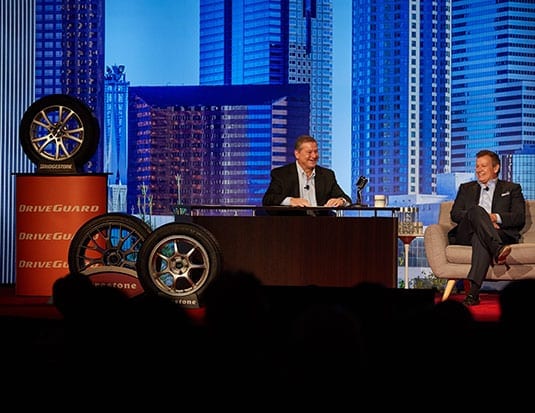Pre and post repair scans make a powerful difference.
At last year’s NACE Expo in Anaheim, Calif., Mike Anderson interviewed two insurers and six OEMs and asked them, “What could happen if a collision repair shop doesn’t scan a vehicle before and after a repair?”
Anderson, President of Collision- Advice, remembers that the response was basically, “Someone could die.”
“In the U.S., seven vehicle manufacturers have now mandated that you need to scan a vehicle before it’s released back to the customer,” he says. “You’ll find their position statements at oem1stop.com, specifying that it’s necessary to scan any vehicle 1996 and newer when you do collision repair.”
As an example, Anderson offers the case of a collision repair shop in Connecticut that replaced a bumper cover, a grille, and a grill emblem on a Toyota—a minor repair. “The vehicle needed a clear grille emblem, but the shop put a charcoal gray emblem on by mistake,” he says. “The colour and clarity of the grille emblem impacted the performance of the cruise control, and that could have been a huge liability for the shop. It’s critical to scan a vehicle to ensure that everything’s properly repaired and working, even something as simple as a grille emblem. The collision avoidance and safety systems have really changed the game and the way we do things.”
Special order for sensors
The need for a scan tool used to be quite rare, recalls Jack Rozint, Vice President, Sales and Service Repairs, Auto Physical Damage at Mitchell International. “When the need came up, you might put the car on a flat-bed and take it to the dealership and let the dealership use the scan tool. That was okay, because it was only every 30 or 50 cars. Now, it’s becoming more and more necessary.”
Taking the car to a dealership disrupts repair productivity and is costly. “Using an aftermarket tool may not have all the functionality of the OEM tool, but it can tell you the diagnostic condition of the vehicle,” says Rozint. “There are also a couple of remote services that have the ability to link to scan tools or scan tool technology using Internet connectivity.”
Doing a pre-repair scan can identify damage that may have been previously missed. “If you do a pre-repair scan on a vehicle that seemed like a light hit with not much damage, you may find a damaged sensor,” says Rozint. “There may be no visible way of knowing that. Being able to identify that early in the process gives you the opportunity to do further investigation.”
Sensors and electronic components are not available the same day for delivery, and finding that you need one at the last minute can delay the repair. “These are usually special order parts, so being able to put the scan tool on the vehicle at the time you’re creating the repair plan gives you the option of identifying and making parts orders correctly the first time,” notes Rozint. “Diagnostic tools and equipment are definitely becoming more a part of the collision repair process.”
“Diagnostic equipment is becoming a part of the collision repair process.” — Jack Rozint, Vice President, Sales & Service Repairs, Auto Physical Damage Solutions, Mitchell International
Insurers want to make sure vehicles are repaired correctly and returned to a safe operating condition, and recognize that scan tools and diagnostics are required for that on many newer model vehicles. “The disconnect with insurers is when you say every vehicle 1996 and newer has to go through this process. That’s when the insurers have a hard time making a jump, because it makes a significant impact on repair costs,” says Rozint.
Insurance pays for scan
In the U.S., Chubb Insurance recently announced it will pay for an hour of labour time for a pre-scan and an hour of labour time for a post-scan on any 1990 and newer vehicle. “The majority of insurance companies are taking a ‘wait and see’ approach,” says Jeff Toom, Senior Business Analyst with OE Connection. “Chubb Insurance is the first one to announce to the shops that this is what they want, and this is how much they’ll pay.”
He expects that as more cases are identified as necessary, the insurance companies will follow suit and pay for it to varying degrees. “Cars will only continue to get more complicated. That’s where OEM procedures become so important that technicians and estimators at collision repair shops as well as insurance companies will be paying close attention to repair procedures to know what is expected to get the car completed to full specifications,” Toom says. Toom also says part of the onus is on dealers to be aware that the estimating systems allow the shops to make a choice. “The shops could pick the wrong parts. They can’t always assume the part specified by the shop is the exact part that the shop wants,” he says. “That impacts the repair because the dealer has to make an extra trip and the consumer has to wait.” NASA involved And it’s not just the insurers and manufacturers who are pushing for pre and post repair scans. According to Steve Zack, Technical Instructor at Bosch Canada, pressure for pre and post-repair tests is also coming from
“Cars will only continue to get more complicated. That’s where OEM procedures become so important that technicians and estimators at collision repair shops as well as insurance companies will be paying close attention to repair procedures to know what is expected to get the car completed to full specifications,” Toom says. Toom also says part of the onus is on dealers to be aware that the estimating systems allow the shops to make a choice. “The shops could pick the wrong parts. They can’t always assume the part specified by the shop is the exact part that the shop wants,” he says. “That impacts the repair because the dealer has to make an extra trip and the consumer has to wait.” NASA involved And it’s not just the insurers and manufacturers who are pushing for pre and post repair scans. According to Steve Zack, Technical Instructor at Bosch Canada, pressure for pre and post-repair tests is also coming from
Toom also says part of the onus is on dealers to be aware that the estimating systems allow the shops to make a choice. “The shops could pick the wrong parts. They can’t always assume the part specified by the shop is the exact part that the shop wants,” he says. “That impacts the repair because the dealer has to make an extra trip and the consumer has to wait.”
NASA involved
And it’s not just the insurers and manufacturers who are pushing for pre and post repair scans. According to Steve Zack, Technical Instructor at Bosch Canada, pressure for pre and post-repair tests is also coming from government. “A recent article noted that the collision avoidance systems that had been tested in Europe resulted in reducing the death rate by over 10 percent,” says Zack. “That saves a lot of lives, as well as money for insurance claims, medical expenses, and more.”
Bosch supplies two scan tools, the Bosch OTC Evolve and the Bosch OTC Encore. “Whether there are 27 or 59 or 107 controllers on board the vehicle, these tools will talk to all of them, looking for a diagnostic trouble code,” says Zack.
The Bosch tools can do an alignment procedure, offering a target system to which a camera needs to be aligned. “Each brand has a different style target—one might be a checkerboard style, another might be a bulls-eye target, which needs to be set from a certain distance from the front bumper, at a certain width and height,” explains Zack.
“There are more controllers in cars today than there are in airplanes. The communication has to happen in split seconds—these days, NASA is involved in the design of these systems, so you need sophisticated technology.”



